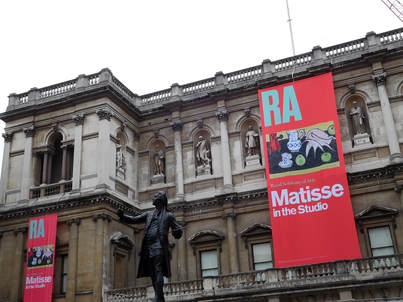 Matisse in the Studio at the Royal Academy of Arts presents a number of works by Henri Matisse along with various objects that are depicted in those works. Henri Matisse was born into a well-to-do merchant family Northern France in 1869. When he became an adult, he saw himself as following a career in the law. To this end, he studied law and when he obtained his qualifications, he found a position as a court administrator. It was not until after his mother gave him a set of art supplies while he was convalescing from an illness that he found art was his true calling. During his long career, Matisse's style continuously evolved as he incorporated new inspirations into his art. He began with traditional European art but along the way drew inspiration from the Impressionists, Post-impressionists, African art and Islamic art as well as from the contemporary art of the first half of the 20th century. While his works sometimes bordered on abstraction, they always held a connection to recognizable real world objects. Throughout his life, the artist collected furniture, utensils, everyday objects and works of art from several cultures that he found visually appealing. Sometimes these objects would appear in his paintings again and again. He analogized them to actors who appear in multiple plays. This exhibit brings together some of these objects along with the works in which they appear. For example, the exhibit includes two silver chocolate pots that appear in a Matisse still life. There is also an ornate Venetian chair that the artist liked to paint. At the end of the day, most of these objects are just ordinary objects. However, they are of interest for two reasons. First, they are objects that once were the possession of a great artist and thus have historical interest just as the hat that Napoleon wore at Waterloo would be of historical interest. Second, they show that a great artist can draw inspiration from an ordinary object and transform its image into something that is beyond the ordinary. Of greater interest are the works of art from other cultures that Matisse collected. Objects such as African masks and sculptures were not so much subjects of his paintings and sculptures but rather things that influenced his style. The influence of the African masks can clearly be seen in his portrait drawings. He has adopted the simplicity of line of the African artists. But, while the African works conceived for religious purposes - did not seek to depict specific individuals, Matissse captured the character of the individuals portrayed. Thus, one can see the evolution of art. Even leaving aside the juxtaposition of the objects and the works of art, this is still a good exhibit. It presents works from across the span of Matisse's career. As a result, it contains quite a few impressive works of art. With regard to the mechanics of the exhibit, there were too many people for the space. Admission was by timed-ticket, which is supposed to prevent overcrowding. Nonetheless, there were too many people in the exhibit area when we were there. The crowd made it difficult to study and appreciate the works. This was compounded by having groups of school children laying on the floor around some of the works trying to do projects related to the exhibit. You had to be careful not to step on anyone. It would have been much better both for all concerned to have had separate times for the classes and for the general public. Comments are closed.
|
AuthorRich Wagner is a writer, photographer and artist. Archives
November 2018
Categories
All
|
 RSS Feed
RSS Feed